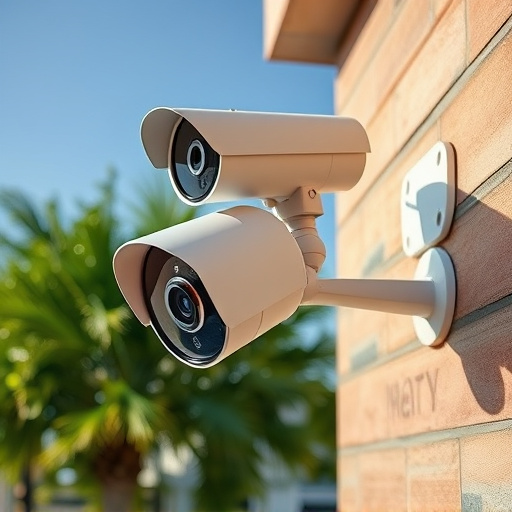Setting up a dummy dome camera requires careful consideration of placement, aiming for optimal visibility through strategic mounting at or slightly above eye level. The Dummy Dome Camera Installation Guide emphasizes planning based on distance to monitored areas, manufacturer guidelines, and environmental factors like lighting and weather to ensure clear, unobstructed footage 24/7. Key installation steps include assessing line-of-sight, using suitable hardware for secure attachment, and positioning above eye level for discretion while maintaining comprehensive coverage. Correct height (2-3 feet above eye level) and downward angle adjustments prevent blind spots, enhancing security and surveillance effectiveness in compliance with local regulations regarding public visibility.
Looking for the perfect spot to install your dummy dome camera? This comprehensive guide is your go-to resource. We’ll walk you through everything from understanding the essential placement requirements of a dummy dome camera to measuring and planning the ideal mounting height for maximum visibility.
Learn best practices for secure and discreet installation, and avoid common setup mistakes that can compromise your security. Get ready to boost your home or business safety with this Dummy Dome Camera Installation Guide.
- Understanding Dummy Dome Camera Placement Requirements
- Measuring and Planning Mounting Height for Optimal Visibility
- Best Practices for Secure and Discreet Installation
- Common Mistakes to Avoid During Setup and Their Solutions
Understanding Dummy Dome Camera Placement Requirements
When setting up a dummy dome camera, understanding its placement requirements is crucial for an effective security system. The ideal mounting height for a Dummy Dome Camera Installation Guide varies based on factors like the camera’s field of view and the area to be monitored. Generally, placing the camera at eye level or slightly elevated provides optimal coverage, ensuring clear and unobstructed vision. This positioning allows the camera to capture detailed footage while maintaining a natural perspective, crucial for identifying individuals and activities.
Additionally, considering the environment is essential. Factors such as lighting conditions, weather exposure, and potential obstructions should be taken into account. Proper placement ensures the camera’s sensors are not blocked, enabling them to function effectively around the clock. A well-planned Dummy Dome Camera Installation Guide accounts for these requirements, enhancing the overall security and surveillance capabilities of the system.
Measuring and Planning Mounting Height for Optimal Visibility
When planning the mounting height for a dummy dome camera, or any security camera for that matter, optimal visibility should be the primary goal. The ideal height allows the camera to capture clear, unobstructed images while maintaining a natural line of sight, mimicking actual surveillance. This is particularly important for deterring potential criminals and ensuring comprehensive coverage.
The best practice is to measure the distance from the proposed mounting point to the area to be monitored. Using this measurement, refer to the manufacturer’s guidelines or industry standards to determine the recommended camera height. For example, in residential settings, a dummy dome camera should generally be installed at a height of 2-3 meters (6-10 feet) above ground level, offering a clear view while remaining discreet. This simple planning step can significantly enhance the effectiveness of your security system.
Best Practices for Secure and Discreet Installation
When installing a dummy dome camera, securing and maintaining discretion are paramount. Begin by assessing your desired placement, considering factors like lighting, line-of-sight, and potential obstructions. Ensure the mounting height aligns with the manufacturer’s guidelines for optimal field of view—typically between 12 to 15 feet (3.6 to 4.5 meters) above the ground for effective coverage.
Use sturdy hardware suitable for your specific environment, whether indoor or outdoor. Secure the camera firmly to avoid tampering, employing methods like locking screws and robust brackets. Positioning the camera slightly higher than eye level adds an extra layer of discretion while ensuring clear visuals. Remember, a well-installed dummy dome camera not only enhances security but also provides peace of mind by deterring potential intruders through its visible presence.
Common Mistakes to Avoid During Setup and Their Solutions
Setting up a security camera, especially a dummy dome camera, requires careful consideration to ensure optimal performance and effectiveness. Common mistakes often arise from overlooking essential factors, such as placement and angle. For instance, mounting the camera too low can result in poor field coverage, while positioning it too high might obstruct key areas of interest. The ideal height for a dummy dome camera is typically around 2-3 feet above eye level, offering a comprehensive view without drawing unnecessary attention.
Another blunder to avoid is failing to adjust the camera’s angle correctly. Cameras should be tilted slightly downwards to capture a wider area and prevent blind spots. Using the Dummy Dome Camera Installation Guide can help ensure accurate positioning. Additionally, checking local regulations regarding security camera placement is crucial; some areas have strict rules about the visibility of cameras from public spaces. Following these simple steps will contribute to a successful and discreet installation.
A well-placed dummy dome camera can significantly enhance security, but achieving optimal effectiveness requires adherence to specific mounting guidelines. By understanding the essential factors like placement requirements and planning for ideal visibility, you ensure a secure and discreet installation. This comprehensive Dummy Dome Camera Installation Guide has equipped you with the knowledge to navigate common mistakes and set up your cameras wisely, ensuring peace of mind in today’s digital era.
